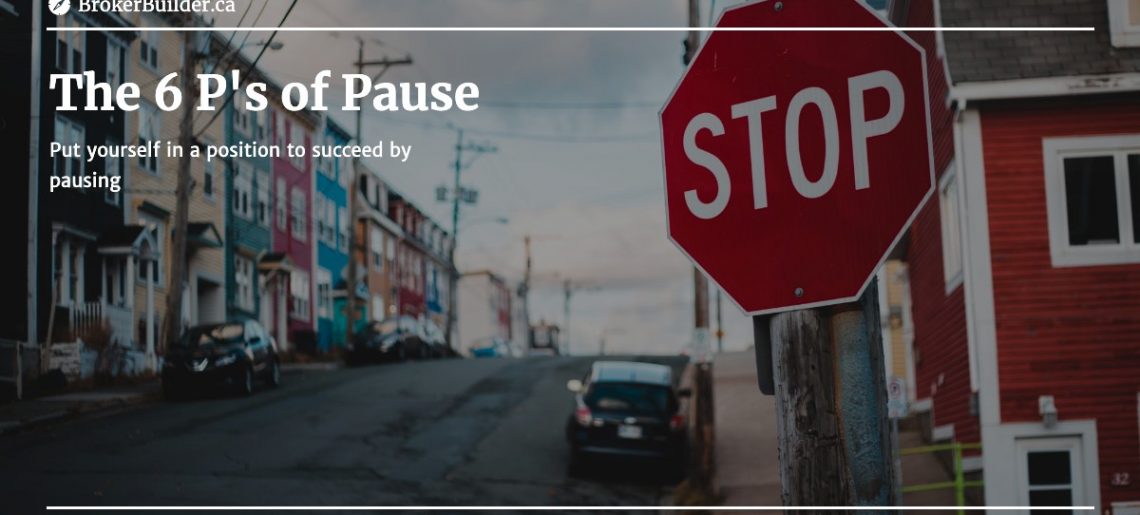Having paid respect to the 6 Ps of Planning some weeks ago, perhaps we can consider adopting a different set of Ps. Let’s consider the 6 Ps of Pause.
In our always on, go-go world, urgency seems a primary driver. The speed of business seems to be supersonic. Perhaps, we can consider being counterintuitive and pause to get more done. Pausing can serve several purposes that may help us in our personal and business lives. Pause to create space. Deep down we recognize the relationship between speed and quality is often inverse. We don’t go to a fast food joint because it’s good food. If we want quality cuisine, we go to a restaurant like Nick’s in Calgary that lists on its menu “good food takes time to prepare”. We go to the restaurant intentionally with the idea that the meal will take time to prepare and we’ll take our time to enjoy it. The additional time of preparation and consumption are strengths not weaknesses. We value more the custom work of craftsman precisely because it took more time and effort to create. We willingly pay more to avoid the factory footwear and have a cobbler craft a pair of leather dress shoes for us even though it takes months instead of minutes.
Most major league baseball pitchers are able to hurl the ball at speeds in excess of 90 MPH. The distance from the pitcher’s mound to home plate is 60 feet. The time taken for the ball to travel is less than half a second. Sport scientists suggest batters have less than a quarter of a second to both evaluate and react to an incoming pitch. This time is almost too short to consciously act. The time between pitch release and opportunity to swiftly swat the bat is so short that the advantage rests with the pitcher. The best batters are likely doing several things to give themselves a chance. The best are able to evaluate sooner the incoming pitch in order to stretch the time available for them to react. Moreover, better batters are working to make these decisions before the pitch is even thrown. They are deciding in advance whether they will or will not act.
Baseball had its steroids scandal in the 90s which coincided with record homerun numbers. The beefy batters bolstered their chances against pitchers by building big biceps. The more recent cheating controversy which plagues the Houston Astros is a more insidious way that batters tried to turn the tables on the advantage of pitchers. When playing at home, the team had access to video feeds. Certain staff were tasked with viewing a live camera feed (against the rules) positioned such that they could see and interpret the signals being sent from catcher to pitcher of opposing team. They were able to identify what was being delivered by the pitcher. This was then relayed to the batter through sounds from other players in the batting team’s dugout. The batter would hear the sound from their dugout, know what was coming, and be able to have time to act. Knowing what was to be delivered was a massive advantage. It completely flips the tables between pitcher and batter. A batter that knows what will be coming can decide before the ball even leaves the pitcher’s hand whether it is something they want to take a swing at or not. Moreover, should they choose to take a swing, they know exactly how and at what angle to slice their bat. Needless to say, teams that undertook this tactic had much better batting averages at home than on the road. Although a completely inappropriate way of trying to obtain an advantage, the objective of creating space within which to make better decisions is a good one.
Frank Partnoy in his book, Wait. The Art and Science of Delay, notes that athletes in several sports, like Tennis, Cricket, Fencing, and baseball are devoted to developing time to create space between when they need to react to incoming acts of their opponent. The best athletes, Partnoy writes, conform to a predictable process, “First, they figure out roughly how much time they will have available to respond. Second, they delay their response as long as they possibly can within that time period.” Partnoy offers, “The superfast athlete’s approach of first observing, second processing, and third acting—at the last possible moment—also works well for our personal and business decisions.”
“Between stimulus and response, there is a space.” —Viktor Frankl
The space can be used for six different but important purposes depending on your circumstances. The 6 Ps of Pause:
Ponder: Pausing provides an opportunity to ponder, to think. Working to increase the time between when we’re confronted with something and when we respond gives us time to consider our options. Tim Urban writes a great blog titled Wait, But Why. The title reflects what we’re trying to do with a Pause. We’re inserting a moment to think. We want to think critically about whatever it is with which we’re faced. We want to demonstrate the characteristic of experts across fields and insert space between stimulus and response in order to give us the best chances for success. Just like we shouldn’t talk with food in our mouth, we should chew on our ideas and formulate a response by pausing instead of responding too quickly with careless, flippant responses. Our reflexive, knee-jerk reactions aren’t usually the best approach to a problem. T.W. Lewis wrties in Solid Ground, “When time allows, no decision is usually the best decision you can make. Many people make important decisions before they really have to and end up getting themselves into trouble. The message here is to delay important decisions for as long as you can and use this extra time to continue to do more research and gather more information so you are better prepared to make the best decision possible.” Better decisions follow deliberate efforts to explore choices.
Prioritize: Pause to provide a chance to prioritize. Determine how to WIN by answering “What’s important Now?”
Percolate: Pause to percolate by allowing the steam of any visceral response to gently evaporate versus erupt. Use the pause to decompress. Let the air out quietly instead of rushing out in a form you will regret. Pause to percolate will lead to a better fate. Seek Seneca’s wisdom, “The best remedy for anger is delay.” Pause to give yourself a chance to let your hot air out slowly. Pause to allow you to avoid blowing your top. Hold off on clicking send on that email, text, comment.
Persevere: Pause to persevere. When faced with frustration, take a breather. Step back. Do something else. This isn’t giving up. It’s not walking away. It may be calling it a day. It’s stepping back, regaining perspective, revitalizing your energy, then attacking your project with renewed vigor.
Pleasure: Pause for pleasure. Take time to take a break. Enjoy a rest. Pause to Purview. Survey your progress. Take in the view from where you are. Pause to soak it in. There is an old joke in psychology that suggests a rite of passage for every psychologist is to write a book that deals with describing a trait that is uniquely human. As in, humans are the only animals that fill in the blank. Well, here goes my effort at becoming a psychologist. Feeling awe at the beauty and amazingness of life and nature is a uniquely human experience. When hiking with Fido in the mountains and cresting a ridge, we pause to purview. We stop to appreciate the vista. Fido may be happy to pause to pant. He may be looking at you with hopes of a treat. He is not the least bit interested at enjoying the view. Pause to pat yourself on the back for how far you’ve come. Pause to enjoy the moment. Pause to savor the flavor of what you’re consuming. Take time to enjoy the moment.
Progress: Pause for Progress. Our muscles grow during the period between efforts. They don’t just grow from repeated efforts. They need periods of rest and recovery. The rest or pause provides the opportunity for growth.
I’m sure we can come up with a never ending list of Ps of Pause with a common thread being that any decision which has potential longer term consequences should imply a healthy dose of pause prior to commitment. The sorts of things that are easy to get into but tough to get out of should imply p-a-u-s-i-n-g prior to action. Long term leases, rentals, car, building, investments all are much easier to get into than to get out of. These are examples of decisions where p-a-u-s-i-n-g should be a priority. Pause to Profit. Hold off on making an investment. Give yourself a chance to think it through. Remember Richard Branson’s advice that investment opportunities are like buses, there’s always another one coming every 15 minutes. Pause to Procure. Hold off on signing that seven year equipment lease or real estate lease. It’s much easier to make than break these commitments. Pause to Procreate. Decisions to have children are one of the most serious that you’ll have. Give yourself time to think it through and set your future up for success.
Adopting the 6 Ps of Pause is a great resource that affords you the ability to give yourself a chance. Consider spending a little time now at the “start” of a new school year to P-A-U-S-E and hit reset for the balance of 2020. Put yourself in a position to succeed by pausing. Go slow to go quick. Pause to work through each of the 6 Ps for yourself and your work role. We’re not pausing in perpetuity. It’s not to give up or stop, but to improve. Pause to get better. That’s it, the 6 Ps of Pause: Ponder, Prioritize, Percolate, Persevere, and Pleasure.
“There are only two times to make a decision: when you have all the information, and when you have to.” —Unknown
Like this email? Please share with a friend. Find past articles here.



